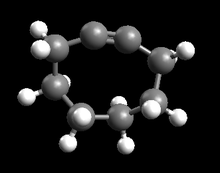Cyclooctyne is the cycloalkyne with a formula C
8H
12. Its molecule has a ring of 8 carbon atoms, connected by seven single bonds and one triple bond.

| |

| |
| Identifiers | |
|---|---|
3D model (JSmol)
|
|
| 1209275 | |
| ChEBI | |
| ChemSpider | |
PubChem CID
|
|
| UNII | |
CompTox Dashboard (EPA)
|
|
| |
| |
| Properties | |
| C8H12 | |
| Molar mass | 108.184 g·mol−1 |
Except where otherwise noted, data are given for materials in their standard state (at 25 °C [77 °F], 100 kPa).
| |
Cyclooctyne is the smallest cycloalkyne that is stable enough to be isolated, although the chemical is still highly reactive. The alkyne region of the structure attempts to adopt a linear molecular geometry, but the nature of the ring creates substantial ring strain. As a result, cyclooctyne and other compounds containing this ring structure readily react in ways that reduce the ring strain by converting the alkyne to a functional group that does not require linear geometry. An important application of this reactivity is in click chemistry, where cyclooctynes undergo cycloaddition reactions with azides[1] or nitrones,[2] forming triazoles or isoxazolines, respectively.
References edit
- ^ Baskin, J. M.; Prescher, J. A.; Laughlin, S. T.; Agard, N. J.; Chang, P. V.; Miller, I. A.; Lo, A.; Codelli, J. A.; Bertozzi, C. R. (2007). "Copper-free click chemistry for dynamic in vivo imaging". Proceedings of the National Academy of Sciences. 104 (43): 16793–7. Bibcode:2007PNAS..10416793B. doi:10.1073/pnas.0707090104. PMC 2040404. PMID 17942682.
- ^ Ning, Xinghai; Temming, Rinske P.; Dommerholt, Jan; Guo, Jun; Blanco-Ania, Daniel; Debets, Marjoke F.; Wolfert, Margreet A.; Boons, Geert-Jan; Van Delft, Floris L. (2010). "Protein Modification by Strain-Promoted Alkyne-Nitrone Cycloaddition". Angewandte Chemie International Edition. 49 (17): 3065–8. doi:10.1002/anie.201000408. PMC 2871956. PMID 20333639.
External links edit
- Media related to Cyclooctyne at Wikimedia Commons